Comparison of the Gaussian Wind Farm Model with Historical Data of Three Offshore Wind Farms
Abstract
:1. Introduction
2. Wind Farms and Measurement Campaigns
3. Data Preprocessing
3.1. Filtering for Self-Flagged Data, Downtime, and Sensor Faults
3.2. Filtering for Wind Turbine Performance Curve Outliers
- Data points with a power production more than 5 kW above the rated power were classified as faulty and removed.
- Curtailment periods and other data outliers are removed by iteratively estimating the mean power curve, defined by coordinates (m/s) and (kW), and removing data entries more than a certain distance to the left or right of this curve. The left bound is defined by the curve and . The right bound is defined by the curve and .
- The performance curve was inspected manually to ensure no outliers were missed.
4. The Energy Ratio as a Calibration and Validation Metric
4.1. The Energy Ratio Defined
4.2. Calibrating Wind Direction Measurements to True North Using the Energy Ratio
4.3. Binning Choices and Their Relation to Temporal and Spatial Effects in the Wind Farm
4.4. The Effect of Model Uncertainty, Turbulence Intensity, and Veer on the Energy Ratio
4.5. Uncertainty Quantification
5. Surrogate Modeling
5.1. Model Parameters
5.2. Heterogeneous Inflow Wind Speed Profile
6. Results
6.1. Validation with Historical Data of the Anholt Offshore Wind Farm
6.2. Validation with Historical Data of the Westermost Rough Offshore Wind Farm
6.3. Validation with Historical Data of the OWEZ Offshore Wind Farm
7. Conclusions
Author Contributions
Funding
Data Availability Statement
Acknowledgments
Conflicts of Interest
Appendix A. FLORIS Choices
| Variable | Relates to | Value |
|---|---|---|
| velocity_model | Wind speed deficit model | gauss_legacy [33,52] |
| turbulence_model | Turbulence intensity model | gauss_legacy [33,53] |
| deflection_model | Wake deflection model | gauss [33,52] |
| combination_model | Wake combination model | sosfs [19] |
| use_secondary_steering | Secondary steering model | True [35] |
| ka | Wake expansion | 0.38 |
| kb | Wake expansion | 0.004 |
| ad | Lateral wake deflection | 0.0 |
| bd | Lateral wake deflection | 0.0 |
| alpha | Transition point near-far wake | 0.58 |
| beta | Transition point near-far wake | 0.077 |
| eps_gain | Value to calculate lateral and vertical flow | 0.2 |
| ti_initial | Turbine-induced turbulence [53] | 0.1 |
| ti_constant | Turbine-induced turbulence [53] | 0.5 |
| ti_ai | Turbine-induced turbulence [53] | 0.8 |
| ti_downstream | Turbine-induced turbulence [53] | −0.32 |
References
- Siemens-Gamesa Renewable Energy. Wake Adapt Solution, 2019. Promotional Video; Product Advertisement. Available online: https://www.siemensgamesa.com/en-int (accessed on 4 March 2022).
- Fleming, P.A.; Annoni, J.R.; Shah, J.J.; Wang, L.; Ananthan, S.; Zhang, Z.; Hutchings, K.; Wang, P.; Chen, W.; Chen, L. Field test of wake steering at an offshore wind farm. Wind. Energy Sci. 2017, 2, 229–239. [Google Scholar] [CrossRef] [Green Version]
- Howland, M.F.; Lele, S.K.; Dabiri, J.O. Wind farm power optimization through wake steering. Proc. Natl. Acad. Sci. USA 2019, 116, 14495–14500. [Google Scholar] [CrossRef] [PubMed] [Green Version]
- Fleming, P.A.; King, J.R.; Dykes, K.; Simley, E.; Roadman, J.; Scholbrock, A.K.; Murphy, P.; Lundquist, J.K.; Moriarty, P.J.; Fleming, K.; et al. Initial results from a field campaign of wake steering applied at a commercial wind farm—Part 1. Wind. Energy Sci. 2019, 4, 273–285. [Google Scholar] [CrossRef] [Green Version]
- Fleming, P.A.; King, J.R.; Simley, E.; Roadman, J.; Scholbrock, A.; Murphy, P.; Lundquist, J.K.; Moriarty, P.J.; Fleming, K.; van Dam, J.; et al. Continued results from a field campaign of wake steering applied at a commercial wind farm—Part 2. Wind. Energy Sci. 2020, 5, 945–958. [Google Scholar] [CrossRef]
- Doekemeijer, B.M.; Kern, S.; Kanev, S.K.; Salbert, B.; Schreiber, J.; Campagnolo, F.; Bottasso, C.L.; Maturu, S.; Schuler, S.; Wilts, F.; et al. Field experiment for open-loop yaw-based wake steering at a commercial onshore wind farm in Italy. Wind. Energy Sci. 2021, 6, 159–176. [Google Scholar] [CrossRef]
- Fleming, P.A.; Sinner, M.; Young, T.; Lannic, M.; King, J.R.; Simley, E.; Doekemeijer, B.M. Experimental results of wake steering using fixed angles. Wind. Energy Sci. Discuss. 2021, 2021, 1–18. [Google Scholar] [CrossRef]
- Simley, E.; Fleming, P.A.; Girard, N.; Alloin, L.; Godefroy, E.; Duc, T. Results from a Wake Steering Experiment at a Commercial Wind Plant: Investigating the Wind Speed Dependence of Wake Steering Performance. Wind. Energy Sci. Discuss. 2021, 2021, 1–39. [Google Scholar] [CrossRef]
- Van Wingerden, J.W.; Fleming, P.A.; Göçmen, T.; Eguinoa, I.; Doekemeijer, B.M.; Dykes, K.; Lawson, M.; Simley, E.; King, J.R.; Astrain, D.; et al. Expert Elicitation on Wind Farm Control. Sci. Mak. Torque Wind. 2020, 1618, 22025. [Google Scholar] [CrossRef]
- Fleming, P.A.; van Wingerden, J.W.; Simley, E.; Bay, C.; Doekemeijer, B.M.; Doane, H. Survey prior to kickoff meeting. IEA Task 2021, 2021, 44. [Google Scholar]
- Boersma, S.; Doekemeijer, B.M.; Gebraad, P.M.O.; Fleming, P.A.; Annoni, J.R.; Scholbrock, A.K.; Frederik, J.A.; van Wingerden, J.W. A tutorial on control-oriented modeling and control of wind farms. In Proceedings of the American Control Conference (ACC), Seattle, WA, USA, 24–26 May 2017; pp. 1–18. [Google Scholar]
- Crespo, A.; Hernández, J.; Frandsen, S. Survey of modelling methods for wind turbine wakes and wind farms. Wind Energy 1999, 2, 1–24. [Google Scholar] [CrossRef]
- Rados, K.; Larsen, G.; Barthelmie, R.; Schlez, W.; Lange, B.; Schepers, G.; Hegberg, T.; Magnisson, M. Comparison of Wake Models with Data for Offshore Windfarms. Wind Eng. 2001, 25, 271–280. [Google Scholar] [CrossRef] [Green Version]
- Machielse, L.A.H.; Schepers, J.G.; Eecen, P.J.; Korterink, H.; van de Pijl, S.P. ECN Test Farm Measurements for Validation of Wake Models; Technical Report ECN-M–07-044; TNO: Petten, The Netherlands, 2007. [Google Scholar]
- Renkema, D.J. Validation of Wind Turbine Wake Models. Master’s Thesis, Technical University of Delft, Delft, The Netherlands, 2007. [Google Scholar]
- Jensen, N.O. A note on Wind Generator Interaction; Technical Report RISØ-M-2411; Risø National Laboratory: Roskilde, Denmark, 1983. [Google Scholar]
- Ainslie, J.F. Development of an eddy viscosity model for wind turbine wakes. In Proceedings of the 7th BWEA Wind Energy Conference, Oxford, UK, 27–29 March 1985. [Google Scholar]
- Barthelmie, R.J.; Frandsen, S.T.; Nielsen, M.N.; Pryor, S.C.; Rethore, P.E.; Jørgensen, H.E. Modelling and measurements of power losses and turbulence intensity in wind turbine wakes at Middelgrunden offshore wind farm. Wind Energy 2007, 10, 517–528. [Google Scholar] [CrossRef]
- Katic, I.; Højstrup, J.; Jensen, N.O. A simple model for cluster efficiency. In Proceedings of the European Wind Energy Conference and Exhibition (EWEC), Rome, Italy, 6–8 October 1987; Volume 1, pp. 407–410. [Google Scholar]
- Barthelmie, R.J.; Hansen, K.; Frandsen, S.T.; Rathmann, O.; Schepers, J.G.; Schlez, W.; Phillips, J.; Rados, K.; Zervos, A.; Politis, E.S.; et al. Modelling and measuring flow and wind turbine wakes in large wind farms offshore. Wind Energy 2009, 12, 431–444. [Google Scholar] [CrossRef]
- Barthelmie, R.J.; Pryor, S.C.; Frandsen, S.T.; Hansen, K.S.; Schepers, J.G.; Rados, K.; Schlez, W.; Neubert, A.; Jensen, L.E.; Neckelmann, S. Quantifying the Impact of Wind Turbine Wakes on Power Output at Offshore Wind Farms. J. Atmos. Ocean. Technol. 2010, 27, 1302–1317. [Google Scholar] [CrossRef]
- Beaucage, P.; Robinson, N.; Alonge, C.; Brower, M. Overview of Six Commercial and Research Wake Models for Large Offshore Wind Farms. In Proceedings of the European Wind Energy Conference and Exhibition, Copenhagen, Denmark, 16–19 April 2012. [Google Scholar]
- Gaumond, M.; Réthoré, P.E.; Ott, S.; Peña, A.; Bechmann, A.; Hansen, S. Evaluation of the wind direction uncertainty and its impact on wake modeling at the Horns Rev offshore wind farm. Wind Energy 2014, 17, 1169–1178. [Google Scholar] [CrossRef] [Green Version]
- Nygaard, N.G. Wakes in very large wind farms and the effect of neighbouring wind farms. J. Physics Conf. Ser. 2014, 524, 012162. [Google Scholar] [CrossRef]
- Nygaard, N.G. Systematic Quantification of Wake Model Uncertainty; European Wind Energy Association: Brussels, Belgium, 2015; pp. 1–10. [Google Scholar]
- Tian, L.; Zhu, W.; Shen, W.; Zhao, N.; Shen, Z. Development and validation of a new two-dimensional wake model for wind turbine wakes. J. Wind. Eng. Ind. Aerodyn. 2015, 137, 90–99. [Google Scholar] [CrossRef] [Green Version]
- Walker, K.; Adams, N.; Gribben, B.; Gellatly, B.; Nygaard, N.G.; Henderson, A.; Marchante Jimémez, M.; Schmidt, S.R.; Rodriguez Ruiz, J.; Paredes, D.; et al. An evaluation of the predictive accuracy of wake effects models for offshore wind farms. Wind Energy 2016, 19, 979–996. [Google Scholar] [CrossRef]
- Archer, C.L.; Vasel-Be-Hagh, A.; Yan, C.; Wu, S.; Pan, Y.; Brodie, J.F.; Maguire, A.E. Review and evaluation of wake loss models for wind energy applications. Appl. Energy 2018, 226, 1187–1207. [Google Scholar] [CrossRef]
- Nygaard, N.G.; Newcombe, A.C. Wake behind an offshore wind farm observed with dual-Doppler radars. J. Physics: Conf. Ser. 2018, 1037, 072008. [Google Scholar] [CrossRef]
- Nygaard, N.G.; Steen, S.T.; Poulsen, L.; Pedersen, J.G. Modelling cluster wakes and wind farm blockage. J. Phys. Conf. Ser. 2020, 1618, 062072. [Google Scholar] [CrossRef]
- Hamilton, N.; Bay, C.J.; Fleming, P.A.; King, J.; Martínez-Tossas, L.A. Comparison of modular analytical wake models to the Lillgrund wind plant. J. Renew. Sustain. Energy 2020, 12, 053311. [Google Scholar] [CrossRef]
- Jiménez, A.; Crespo, A.; Migoya, E. Application of a LES technique to characterize the wake deflection of a wind turbine in yaw. Wind Energy 2010, 13, 559–572. [Google Scholar] [CrossRef]
- Bastankhah, M.; Porté-Agel, F. Experimental and theoretical study of wind turbine wakes in yawed conditions. J. Fluid Mech. 2016, 806, 506–541. [Google Scholar] [CrossRef]
- Martínez-Tossas, L.A.; Annoni, J.R.; Fleming, P.A.; Churchfield, M.J. The Aerodynamics of the Curled Wake: A Simplified Model in View of Flow Control. Wind. Energy Sci. 2019, 4, 127–138. [Google Scholar] [CrossRef] [Green Version]
- King, J.; Fleming, P.A.; King, R.; Martínez-Tossas, L.A.; Bay, C.J.; Mudafort, R.; Simley, E. Control-oriented model for secondary effects of wake steering. Wind. Energy Sci. 2021, 6, 701–714. [Google Scholar] [CrossRef]
- Ahmad, T.; Coupiac, O.; Petit, A.; Guignard, S.; Girard, N.; Kazemtabrizi, B.; Matthews, P.C. Field Implementation and Trial of Coordinated Control of WIND Farms. IEEE Trans. Sustain. Energy 2018, 9, 1169–1176. [Google Scholar] [CrossRef] [Green Version]
- van der Hoek, D.; Kanev, S.; Allin, J.; Bieniek, D.; Mittelmeier, N. Effects of axial induction control on wind farm energy production—A field test. Renew. Energy 2019, 140, 994–1003. [Google Scholar] [CrossRef]
- Bossanyi, E.; Ruisi, R. Axial induction controller field test at Sedini wind farm. Wind. Energy Sci. 2021, 6, 389–408. [Google Scholar] [CrossRef]
- NREL. FLASC: A Rich Floris-Driven Suite for SCADA Analysis. Version 0.1. 2022. Available online: https://github.com/nrel/flasc (accessed on 4 March 2022).
- Quick, J.; Annoni, J.; King, R.; Dykes, K.; Fleming, P.; Ning, A. Optimization Under Uncertainty for Wake Steering Strategies. J. Phys. Conf. Ser. 2017, 854, 012036. [Google Scholar] [CrossRef]
- Rott, A.; Doekemeijer, B.M.; Seifert, J.; van Wingerden, J.W.; Kühn, M. Robust active wake control in consideration of wind direction variability and uncertainty. Wind Energy Sci. 2018, 3, 869–882. [Google Scholar] [CrossRef] [Green Version]
- Simley, E.; Fleming, P.A.; King, J.R. Design and Analysis of a Wake Steering Controller with Wind Direction Variability. Wind Energy Sci. 2020, 5, 451–468. [Google Scholar] [CrossRef] [Green Version]
- Kanev, S.; Bot, E. Dynamic robust active wake control. Wind. Energy Sci. Discuss. 2021, 2021, 1–30. [Google Scholar] [CrossRef]
- Mittelmeier, N.; Blodau, T.; Kühn, M. Monitoring offshore wind farm power performance with SCADA data and an advanced wake model. Wind Energy Sci. 2017, 2, 175–187. [Google Scholar] [CrossRef]
- Gebraad, P.M.O.; Teeuwisse, F.W.; van Wingerden, J.W.; Fleming, P.A.; Ruben, S.D.; Marden, J.R.; Pao, L.Y. Wind plant power optimization through yaw control using a parametric model for wake effects—A CFD simulation study. Wind Energy 2016, 19, 95–114. [Google Scholar] [CrossRef]
- IEA-Wind. IEA Wind Task 44. 2021. Available online: https://iea-wind.org/task44/ (accessed on 4 March 2022).
- Efron, B.; Tibshirani, R.J. An Introduction to the Bootstrap; Chapman & Hall: London, UK, 1993. [Google Scholar]
- NREL. FLORIS. Version 2.4. 2021. Available online: https://github.com/nrel/floris (accessed on 4 March 2022).
- Farrell, A.; King, J.; Draxl, C.; Mudafort, R.; Hamilton, N.; Bay, C.J.; Fleming, P.; Simley, E. Design and analysis of a wake model for spatially heterogeneous flow. Wind Energy Sci. 2021, 6, 737–758. [Google Scholar] [CrossRef]
- Bastankhah, M.; Welch, B.L.; Martínez-Tossas, L.A.; King, J.; Fleming, P.A. Analytical solution for the cumulative wake of wind turbines in wind farms. J. Fluid Mech. 2021, 911, A53. [Google Scholar] [CrossRef]
- Doekemeijer, B.M.; van der Hoek, D.C.; van Wingerden, J.W. Closed-loop model-based wind farm control using FLORIS under time-varying inflow conditions. Renew. Energy 2020, 156, 719–730. [Google Scholar] [CrossRef]
- Bastankhah, M.; Porté-Agel, F. A new analytical model for wind-turbine wakes. Renew. Energy 2014, 70, 116–123. [Google Scholar] [CrossRef]
- Crespo, A.; Hernández, J. Turbulence characteristics in wind-turbine wakes. J. Wind. Eng. Ind. Aerodyn. 1996, 61, 71–85. [Google Scholar] [CrossRef]


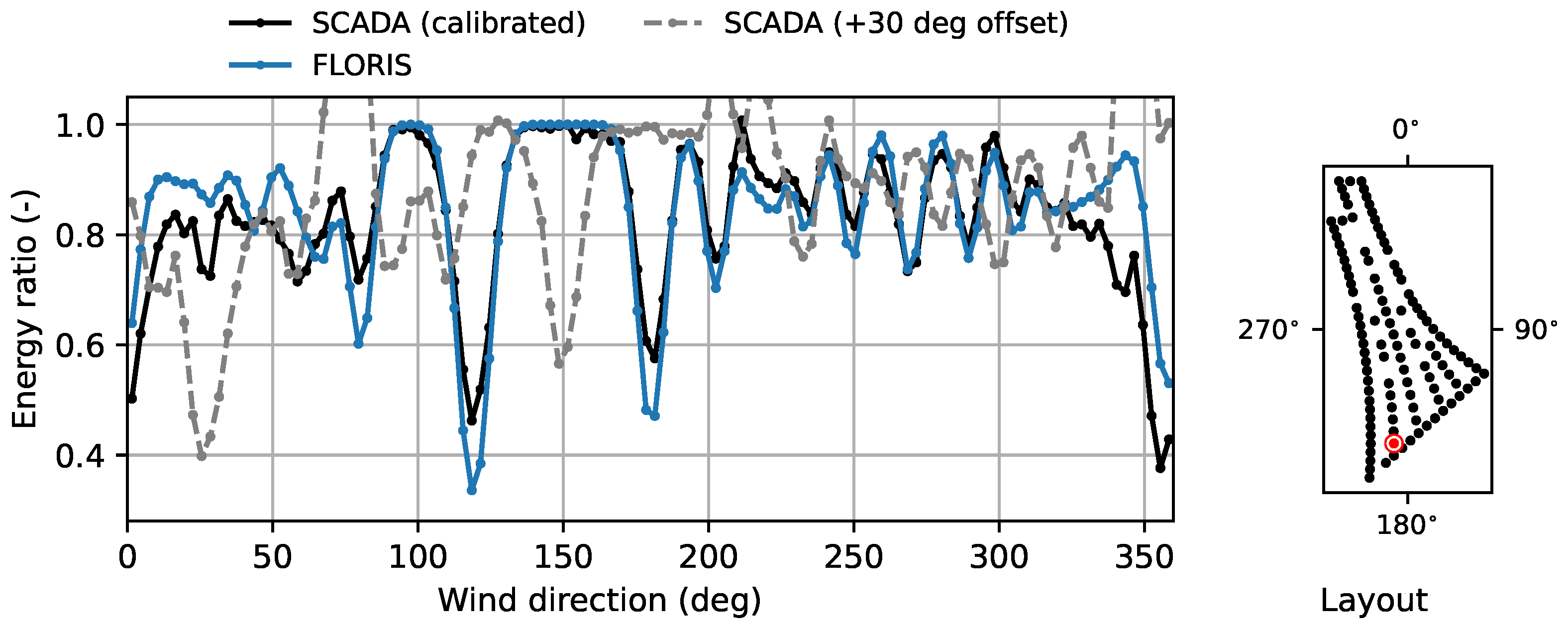
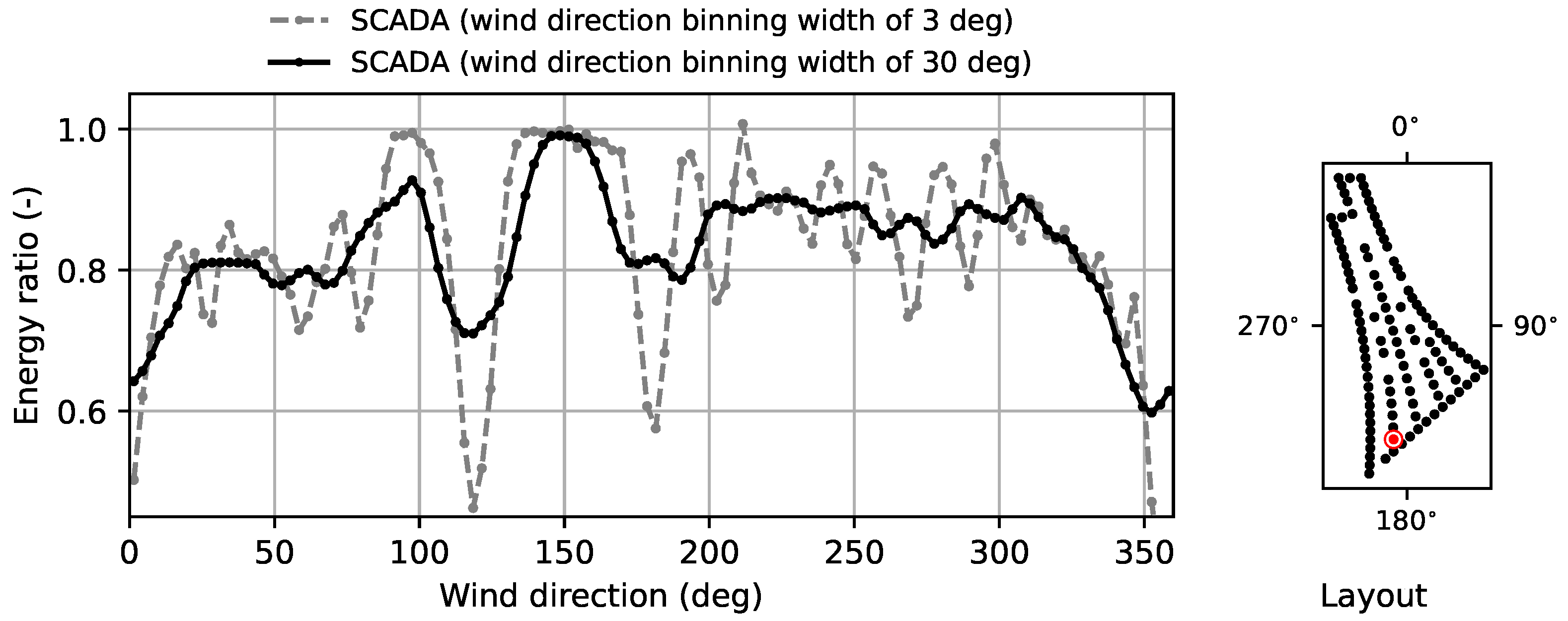




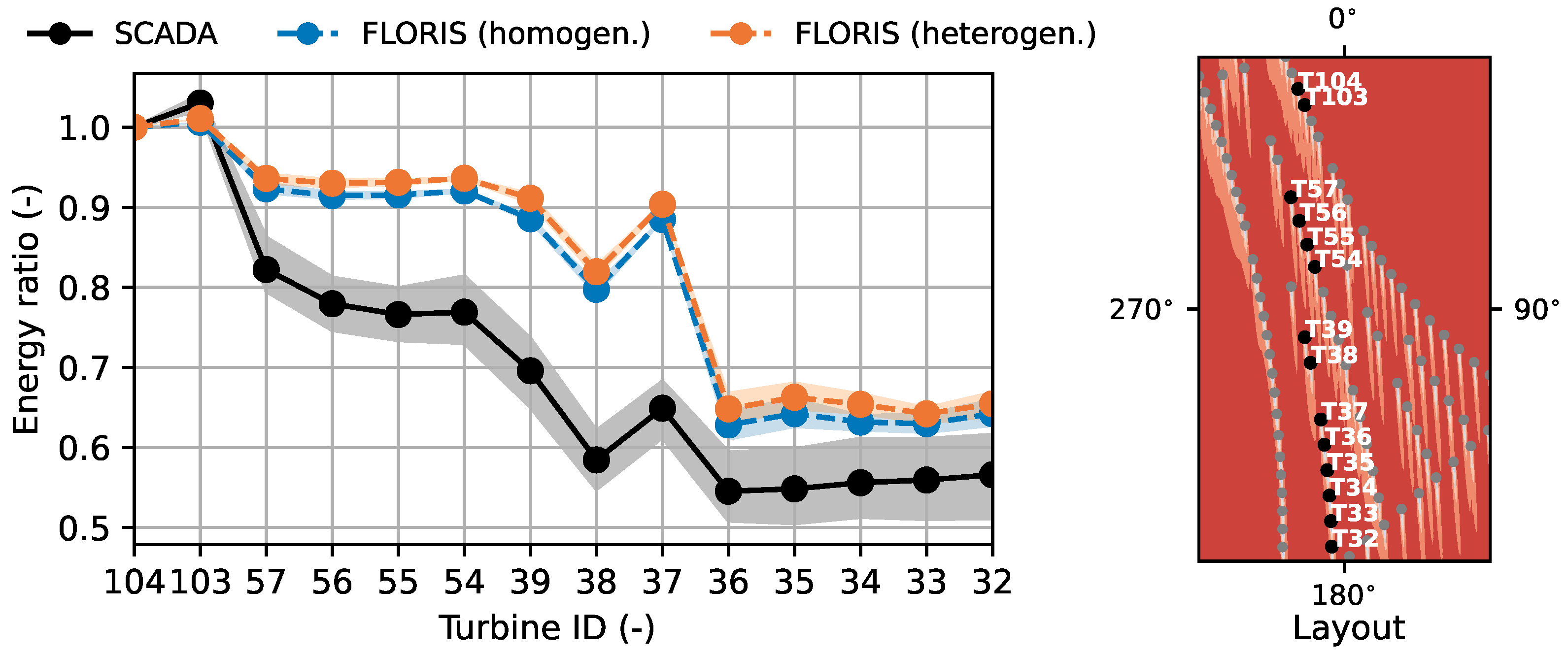
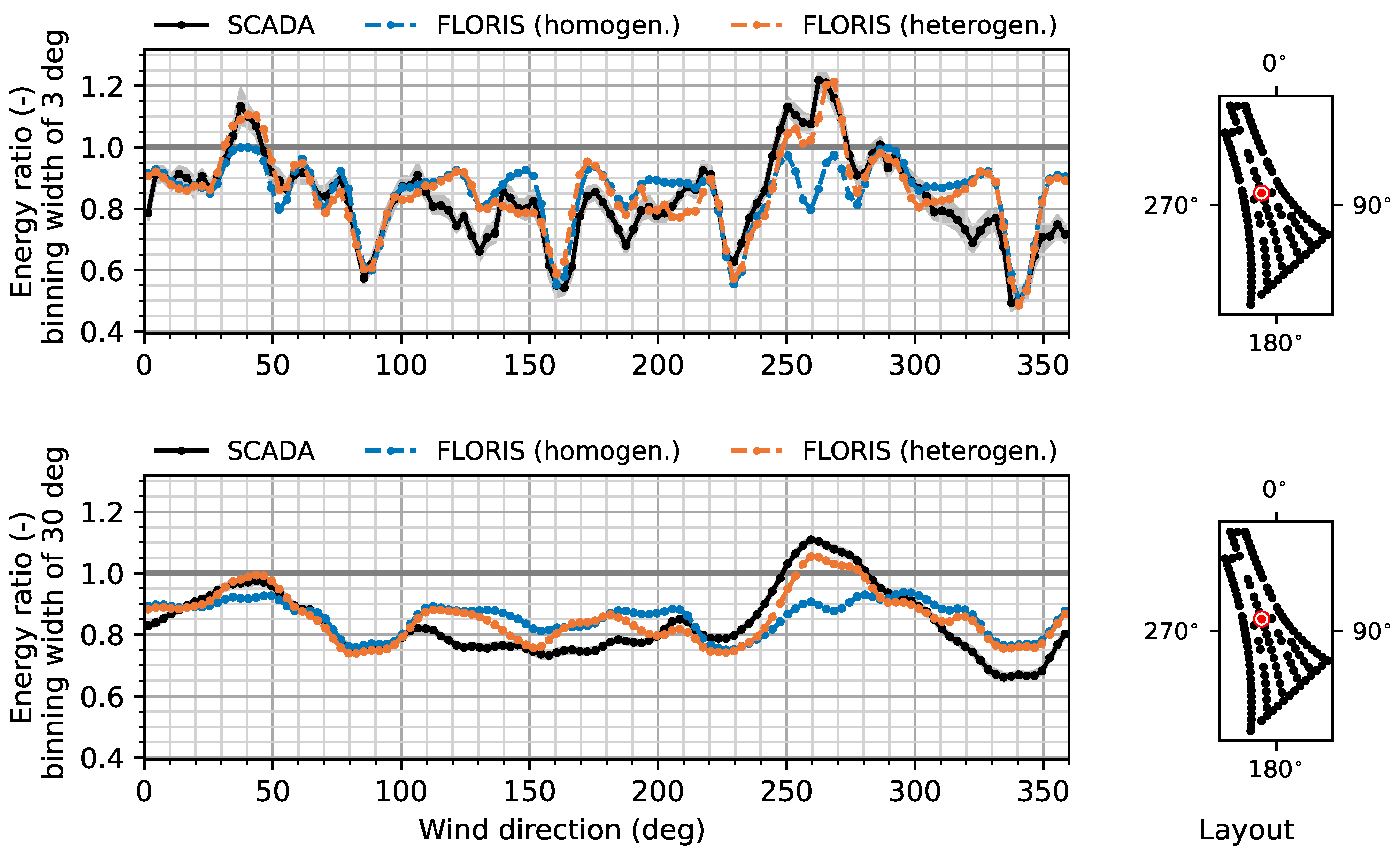



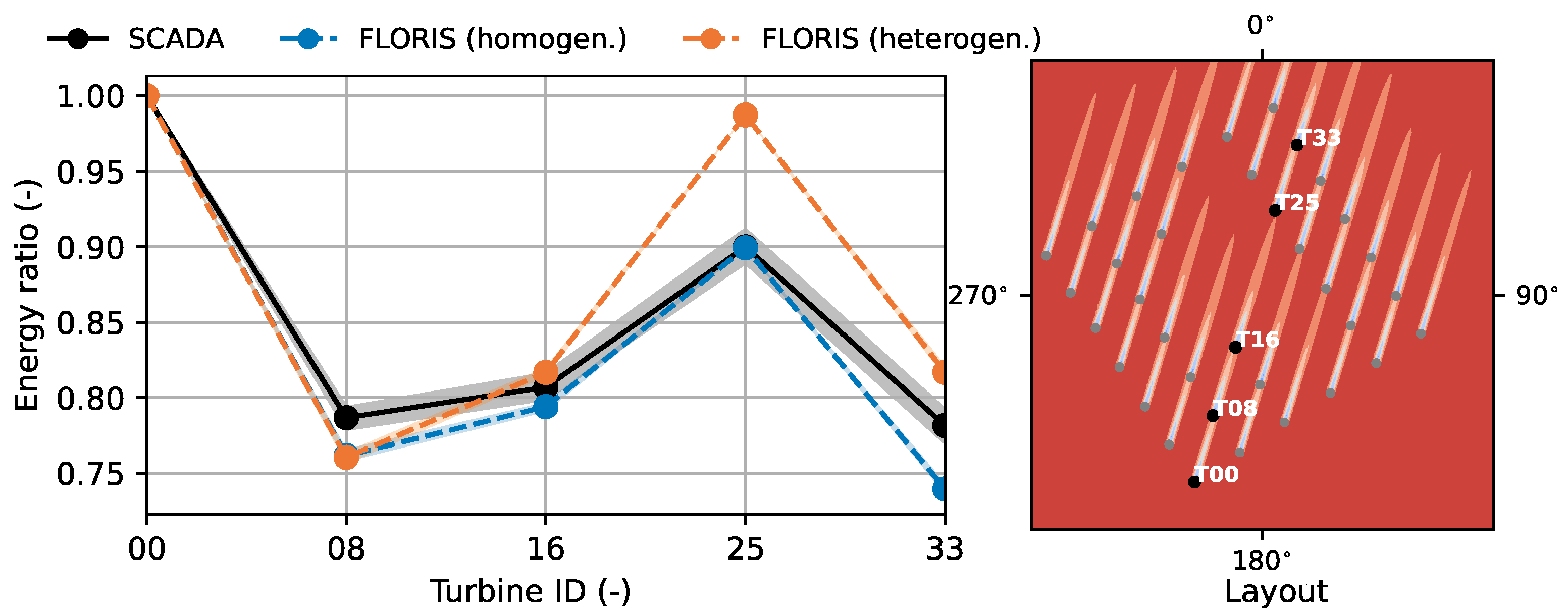
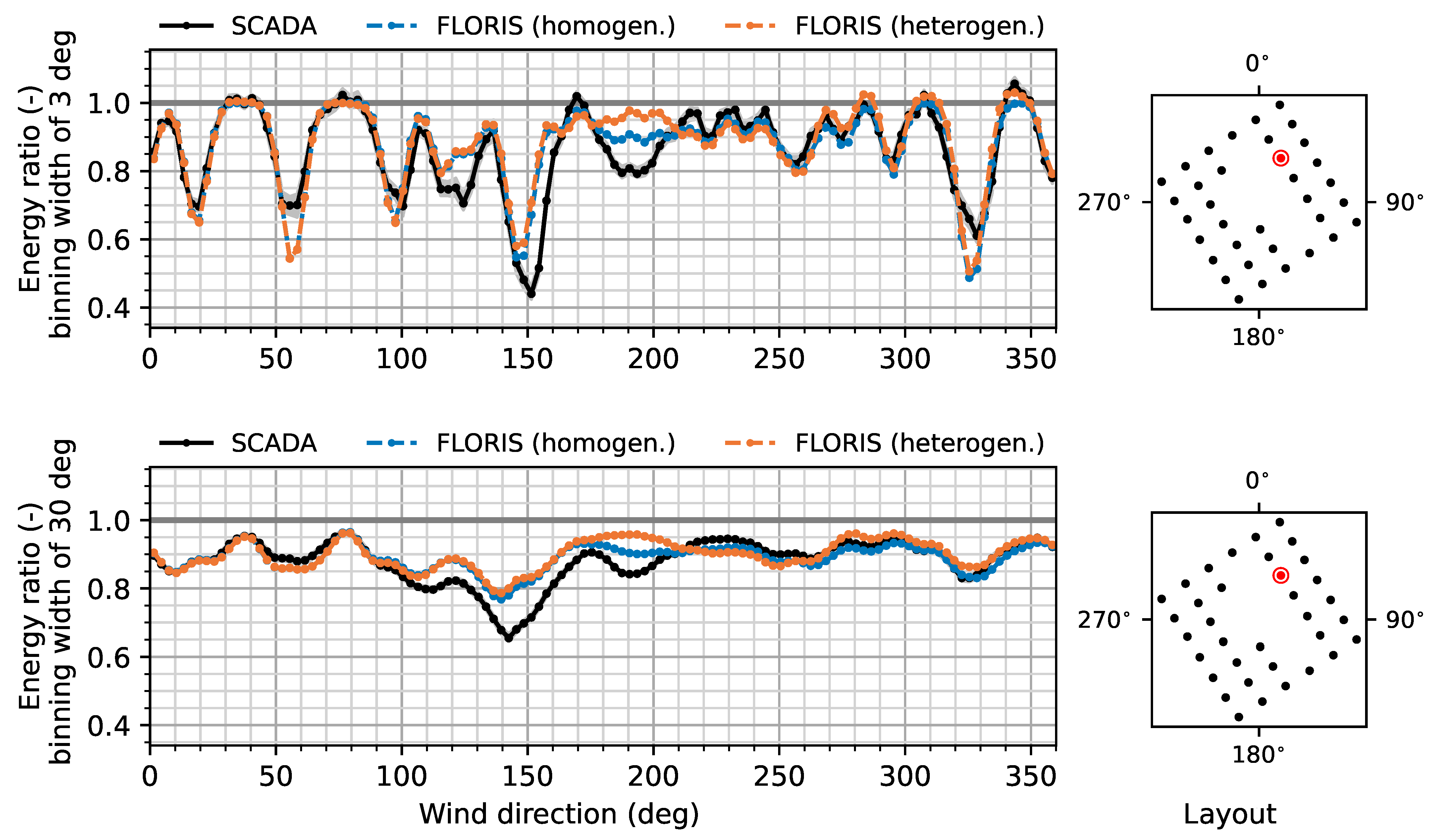


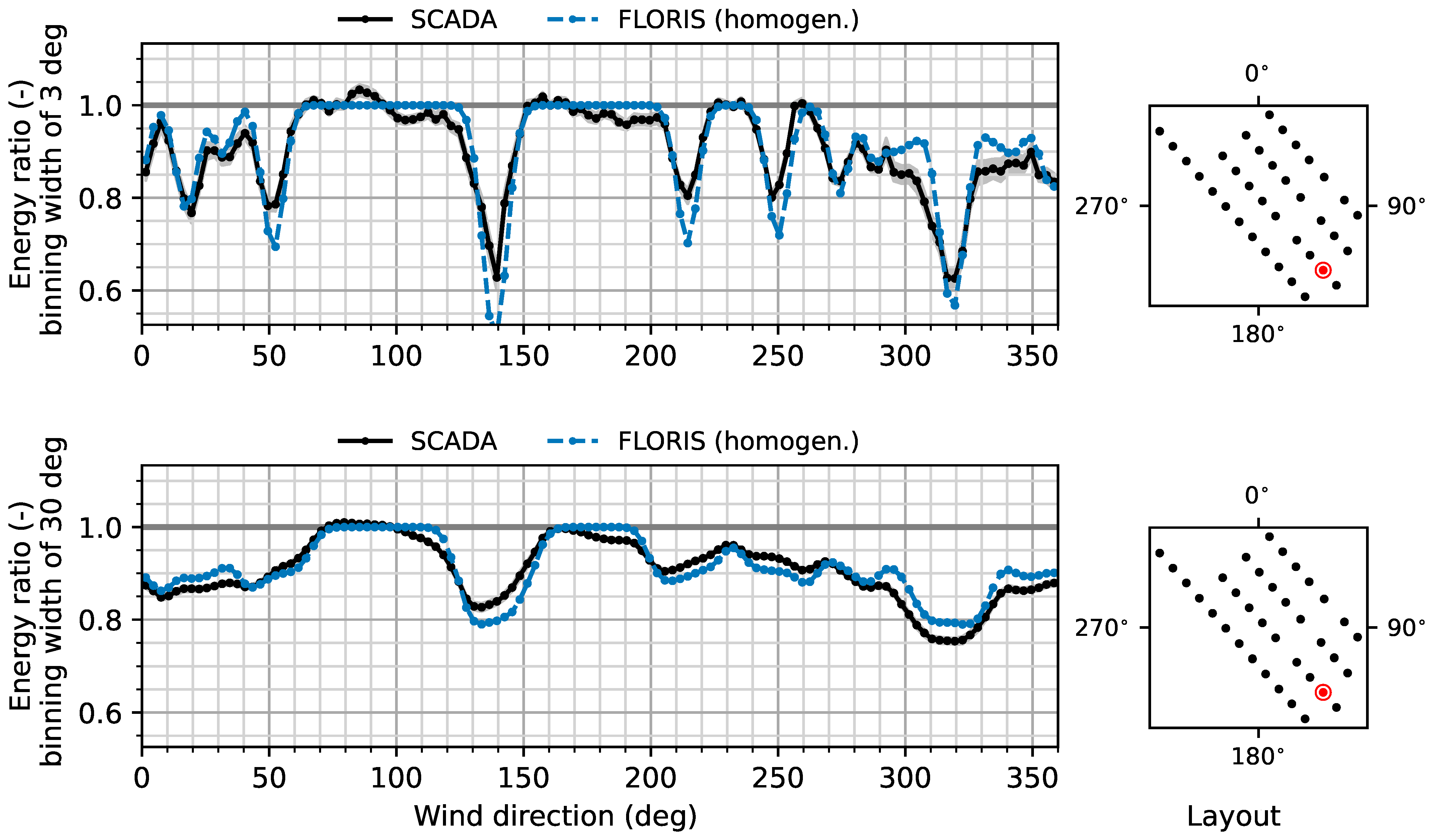
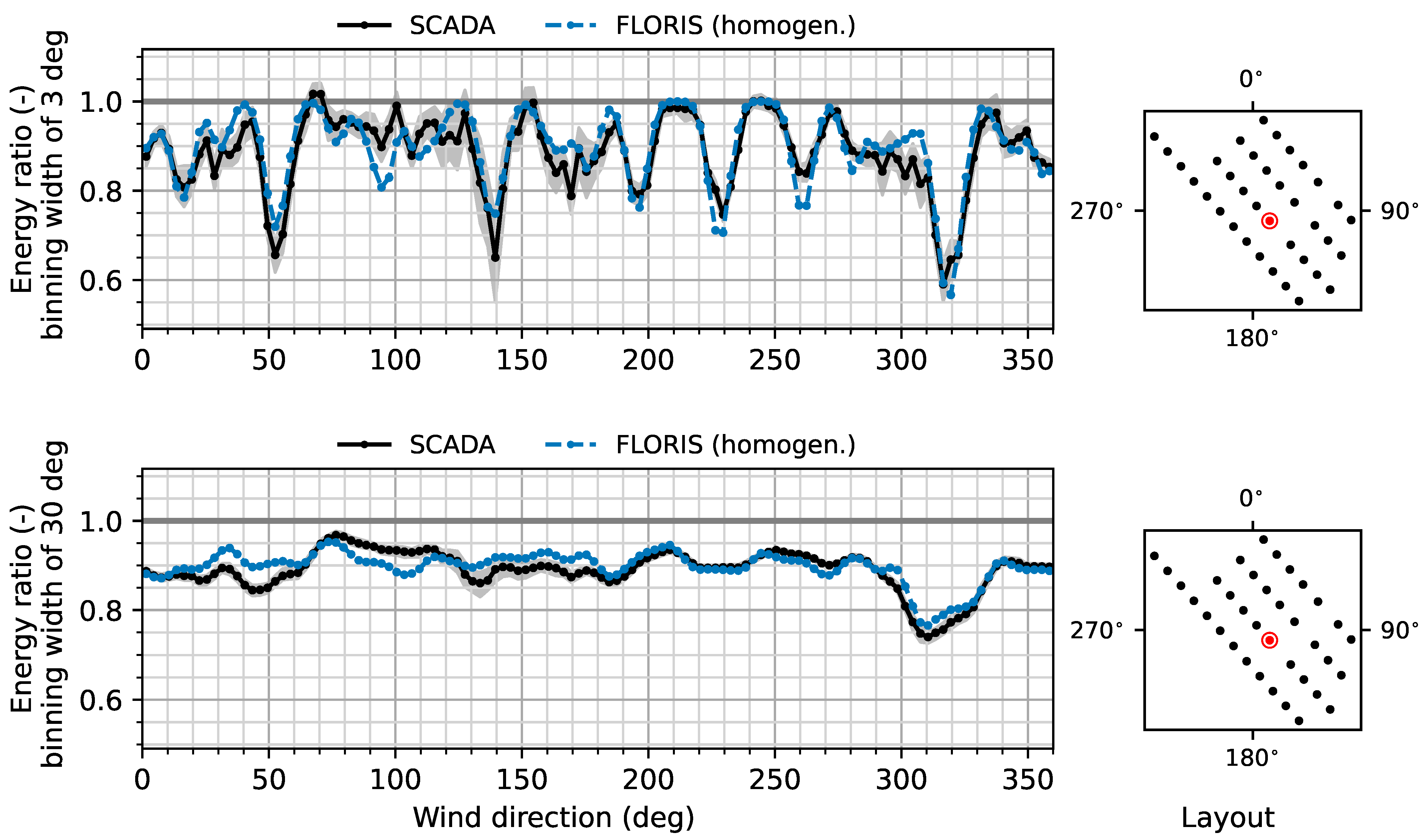
| Farm Name | Anholt | OWEZ | Westermost Rough |
|---|---|---|---|
| No. of turbines | 111 | 36 | 35 |
| Rotor diameter, D (m) | 120.0 | 90.0 | 154.0 |
| Turbine capacity (MW) | 3.6 | 3.0 | 6.0 |
| Min. turbine spacing (D) | 5 | 7 | 6 |
Publisher’s Note: MDPI stays neutral with regard to jurisdictional claims in published maps and institutional affiliations. |
© 2022 by the authors. Licensee MDPI, Basel, Switzerland. This article is an open access article distributed under the terms and conditions of the Creative Commons Attribution (CC BY) license (https://creativecommons.org/licenses/by/4.0/).
Share and Cite
Doekemeijer, B.M.; Simley, E.; Fleming, P. Comparison of the Gaussian Wind Farm Model with Historical Data of Three Offshore Wind Farms. Energies 2022, 15, 1964. https://doi.org/10.3390/en15061964
Doekemeijer BM, Simley E, Fleming P. Comparison of the Gaussian Wind Farm Model with Historical Data of Three Offshore Wind Farms. Energies. 2022; 15(6):1964. https://doi.org/10.3390/en15061964
Chicago/Turabian StyleDoekemeijer, Bart Matthijs, Eric Simley, and Paul Fleming. 2022. "Comparison of the Gaussian Wind Farm Model with Historical Data of Three Offshore Wind Farms" Energies 15, no. 6: 1964. https://doi.org/10.3390/en15061964






